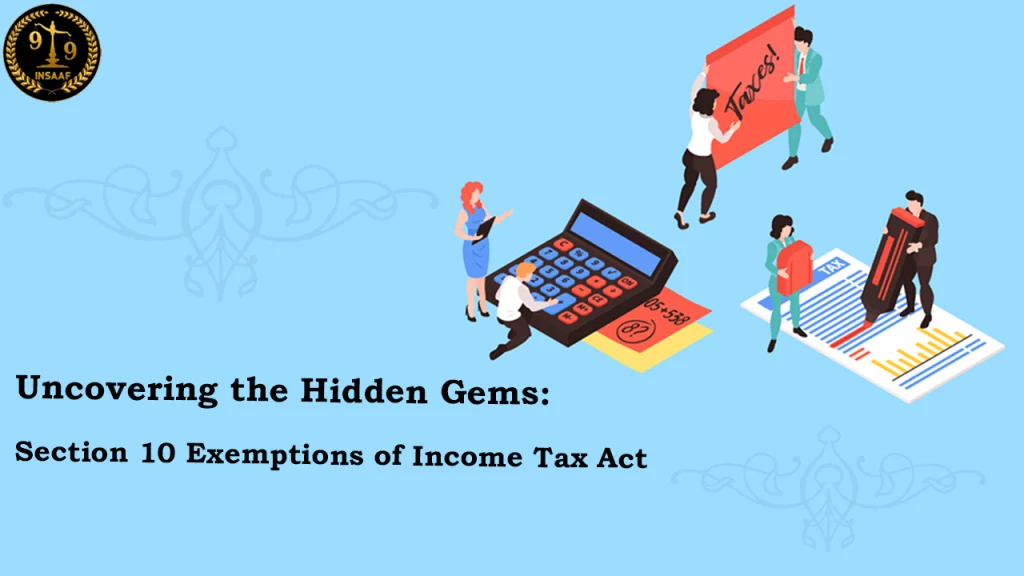

Online Legal Advice from Insaaf99® Online Lawyer Consultation in India


Online Legal Advice from Insaaf99® Online Lawyer Consultation in India

The Indian Income Tax Act, 1961, stands as a towering monument of fiscal legislation, meticulously governing the taxation of income within India. Amidst this intricate framework, Section 10 of Income Tax Act emerges as a beacon of hope for taxpayers, offering a lifeline of exemptions that can significantly reduce their tax burden. Understanding these exemptions is crucial for every taxpayer, as it can translate into substantial tax savings. Let us embark on an enlightening journey into the depths of Section-10, unraveling its diverse array of exemptions and shedding light on the enigmatic Section 10 10D.
Within the complicated system of the Income Tax Act, Section-10 stands as a haven for taxpayers, offering a sanctuary of exemptions that shield their hard-earned incomes from the clutches of taxation. This section explores tax relief options for specific income earners, safeguarding their hard-earned income from excessive taxation.
Agricultural Income (Section-10(1)): A cornerstone of fiscal policy, agricultural income stands as a testament to the nation's commitment to supporting its backbone of food production. This exemption, one of the oldest and most enduring, directly benefits farmers and agriculturalists, rewarding their hard work and dedication.
Family Pension (Section-10(18)): Family pension is a type of retirement benefit that is paid to the dependents of a deceased employee. In India, the income received as a family pension is exempt from tax up to a specified limit. This exemption is provided under Section-10(18) of the Income Tax Act, 1961.
Gratuity Section-10 10D: Gratuity is a one-time payment made by an employer to an employee upon their retirement, resignation, or death. In India, gratuity is exempt from tax up to a specified limit, provided certain conditions are met.
Commuted Pension (Section 10(10A)): When a taxpayer receives a lump sum payment in lieu of their pension, this amount is partially exempt from taxation. The exemption is calculated based on specific rules laid out in the Income Tax Act

Leave Travel Allowance (LTA) (Section 10(5)): The expenses incurred on travel during a specified period are exempt from tax, provided certain conditions are met. Here are some of the conditions that must be met in order to deduct travel expenses:
Housing Rent Allowance (HRA) (Section 10(13A)): HRA received by an employee can be partially or fully exempt from tax, depending on various factors such as the location of residence and the amount of rent paid.
Education Allowance for Children (Section 10(14)): Employers can provide an allowance for the education of an employee's children, which is exempt from taxation, subject to certain limits.
Income from Life Insurance Policies Section 10 10D: This exemption is particularly noteworthy, as it involves the tax treatment of life insurance proceeds. Section 10 10D ensures that the maturity amount or death benefit received from a life insurance policy is fully exempt from tax, subject to specific conditions.
Section 10 10D is a game-changer for those who have invested in life insurance policies. It exempts the maturity amount and death benefit from being taxed, making it a favored choice for long-term savings and financial security. To be eligible for this exemption, the premium paid on the policy should not exceed a specified percentage of the sum assured. This section has played a crucial role in promoting the culture of life insurance in India.
Also Read: - The Strength of Insurance Lawyer: The Key to Peace of Mind
Section 10 10D has been a driving force in promoting the culture of life insurance in India. The benefits of Section 10 10D are manifold:
Section 10 of the Income Tax Act offers numerous exemptions that can help taxpayers reduce their tax burden and maximize their savings. Section 10 10D is particularly important, as it ensures that life insurance benefits remain tax-free. Familiarize yourself with these provisions and take advantage of the opportunities they offer. In essence, Section 10 of the Income Tax Act serves as a guide towards a tax-efficient financial future
Navigate the intricacies of Section 10 exemptions and reap their tax benefits with Insaaf99, an online legal consultation platform. Our team of experts can guide you through the complexities of the Income Tax Act, ensuring you maximize your exemptions. We provide comprehensive explanations of Section 10 exemptions, personalized tax planning, documentation assistance, and representation at tax audits. Empower yourself with Insaaf99's legal expertise to optimize your tax savings and protect your financial interests.
Here are some specific ways Insaaf99 can assist taxpayers: